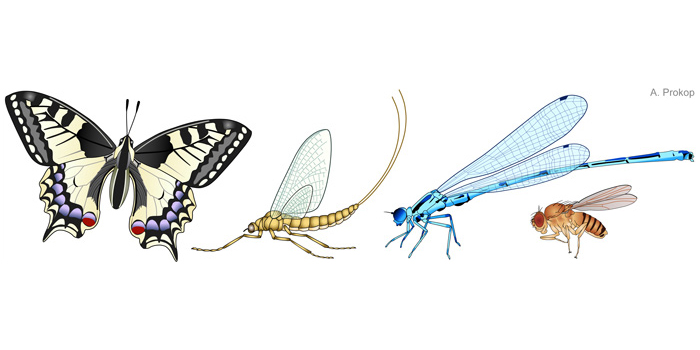Guest authors Sanjai Patel and Andreas Prokop explain why school biology lessons are important places to advocate fundamental biomedical research, and they present strategies developed by the Manchester Fly Facility to bring Drosophila research into primary and secondary classrooms.
The need for fundamental biology research has perhaps never been greater than today, yet the conditions for meaningful biology research are in dire straits (e.g. 15; 5; 46; 42; 23; 25; 16; 12; bulliedintobadscience.org). Rectifying this situation requires science communication (scicomm) based on genuine long-term commitment paired with clever, engaging, and impactful strategies and narratives — aspiring to reach out to relevant target audiences and eventually also convince decision and policy makers.
Today’s school pupils will shape the future of our society. They are therefore a highly relevant audience for scientists who want to have a lasting impact on public support for fundamental research and science-backed policy. There is also clear evidence that experiences in early life impact later attitudes and decision making (1; 6; 17). Importantly, scientists working in fundamental biomedical research have the advantage that their area of expertise tends to be closely related to topics taught in school biology lessons. This provides excellent opportunities to collaborate with teachers in order to improve lesson content and the pupils’ experience of science.
I regularly encounter long-term retention of school experiences when talking with visitors at science fairs about Drosophila research and its importance (36); those who have seen Drosophila in schools, even decades ago, often want to share this experience with me and tend to engage more openly in dialogue from the start. Therefore, engaging with schools should be a no-brainer for scientists with a long-term vision, and we provide here some insights into the school work of the “Manchester Fly Facility” (ManFly) initiative, as an example that readers might find helpful.
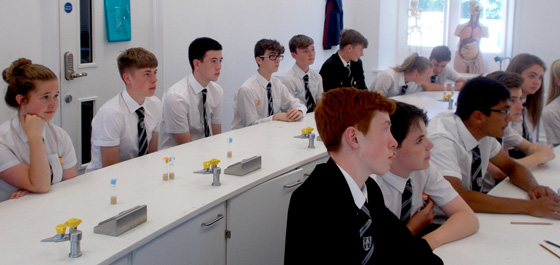
Aims of the “Manchester Fly Facility” scicomm initiative
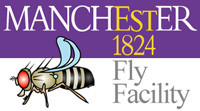 To our knowledge, the Manchester Fly Facility (ManFly) is the only long-term initiative dedicated to communicating and advocating for Drosophila research, alongside more research-oriented initiatives such as DrosAfrica (22; 44)and partly also TReND in Africa. Primarily driven by the two authors of this article, ManFly was launched in 2011 and has gradually expanded into six main areas of activity that reach a wide spectrum of audiences (26b; 27). These include:
To our knowledge, the Manchester Fly Facility (ManFly) is the only long-term initiative dedicated to communicating and advocating for Drosophila research, alongside more research-oriented initiatives such as DrosAfrica (22; 44)and partly also TReND in Africa. Primarily driven by the two authors of this article, ManFly was launched in 2011 and has gradually expanded into six main areas of activity that reach a wide spectrum of audiences (26b; 27). These include:
- the development of resources for fly practical training;
- presentations at science fairs;
- science fair organization (e.g. the “Brain Box” event with over 5K visitors; 37);
- the making of educational movies (19);
- school engagement (see below); and
- encouraging other drosophilists and teachers to adopt our scicomm ideas and resources (see below).
Two of these ManFly activities stand out for their potential impact. Firstly, the fly training resources have had a major impact worldwide, with ~100,000 views and ~31,000 downloads across the four dissemination platforms (8; 28;29;41). Secondly, our school work has had the strongest growth and likely has the biggest future potential, as will be explained in the following.
A more effective way to engage pupils
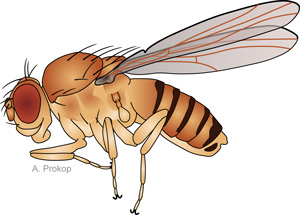 As detailed in previous publications (26b; 27), ManFly’s school outreach was born out of our ideas developed for science fair presentations. Initially, we went into schools to showcase Drosophila research but learned very quickly that this approach is not very effective. Although it does address one important objective of teachers, that is, to bring pupils in contact with real researchers, it is far more powerful to also align with the teachers’ task of conveying curriculum-relevant content. This approach gains the attention of more pupils whilst generating memorable encounters with fruit flies, and it provides excellent opportunities to develop true dialogue between the two professional groups of scientists and teachers.
As detailed in previous publications (26b; 27), ManFly’s school outreach was born out of our ideas developed for science fair presentations. Initially, we went into schools to showcase Drosophila research but learned very quickly that this approach is not very effective. Although it does address one important objective of teachers, that is, to bring pupils in contact with real researchers, it is far more powerful to also align with the teachers’ task of conveying curriculum-relevant content. This approach gains the attention of more pupils whilst generating memorable encounters with fruit flies, and it provides excellent opportunities to develop true dialogue between the two professional groups of scientists and teachers.
By now, ManFly has gathered experiences from over 80 events, including visits to schools, visits by school classes, and teacher seminars. We use these events to optimize our strategies and resources, and have formalized this approach through the launch of the “droso4schools” project in 2015 (10; 26a).
The droso4schools project: teaching with flies not about flies
The overarching objective of droso4schools is to use Drosophila as an effective tool for teaching curriculum-relevant content in biology school classes — ideally to achieve that its use would become a recommended or prescribed strategy in national curricula. Drosophila has essential advantages to this end: fruit fly research covers a broad spectrum of fundamental biology topics, providing excellent conceptual understanding, and there are many opportunities to perform micro-experiments that are memorable, cheap, simple, and easy to set up, even by teachers with little background in this area.
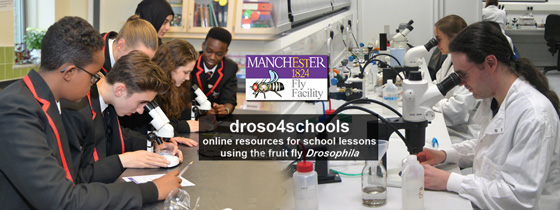
To achieve our objectives we capitalize on mutual collaboration with teachers: we as researchers bring our scientific experience and knowledge and can suggest conceptual improvements to content, and spice things up with engaging anecdotes, experiments, and relevant examples. Teachers provide the essential professional expertise of the curriculum and of effective teaching styles that match the realities of school life.
[youtube https://www.youtube.com/watch?v=DQKFtt3p2C8&w=500]
To implement teacher collaboration and/or get professional feedback, we use three different strategies:
- We place graduate students as teaching assistants in schools and have regular meetings during this placement (10; 26a).
- We invite teachers to continuing professional development events, which is an effective way of obtaining feedback and hearing a wider spectrum of teacher views (2).
- We build trust through repeated extracurricular school visits involving up to 200 pupils experiencing 3–4 different lessons in a single day. This also provides excellent opportunities to test new or improved resources (34).
Box 1. Existing droso4schools sample lessonsAll ManFly lesson resources can be downloaded from our figshare.com repository (38) and have been summarized in a separate blog post (30). Background information is provided on the droso4schools website (20). (1) The climbing assay (statistics): learning data analysis through live experiments with fruit fliesPupils perform a simple experiment used in current research to learn data analysis skills, to organize experimental data into tables and graphs, to interpret trends in data, and to understand the importance of statistics and sample size (PowerPoint also available in Spanish) (2) From gene to enzyme to evolution (alcohol): using alcohol metabolism to illustrate fundamental concepts of biologyPupils learn about metabolism and biological reactions, the genetic code, protein synthesis, genetic diversity and natural selection; includes an enzymatic reaction experiment and an activity about the genetic code (PowerPoint also available in Spanish) (3) Fundamental principles of the nervous systemPupils learn about wiring principles of the nervous system, nerve impulses and transport across membranes, epilepsy, synapses; includes experiments with epileptic and paralyzed flies (suggested extensions: optogenetic tools, sensory discrimination task) (4) Metabolic pathways: investigating the biology and chemistry of pigmentationPupils learn about skin colors, principles of enzymatic pathways, eye pigments in Drosophila and principles of evolution; includes a chromatography experiment (5) Vision: understanding light and light perceptionPupils learn about the nature of light, photo-transduction, image processing, color vision, and color blindness; includes activities on electromagnetic waves, eye anatomy, photo-transduction and a micro-experiment with light diodes and “color blind” flies (6) Life cycles (primary schools)Pupils learn about how organisms from bacteria to humans reproduce, what metamorphosis is, which insects have a pupal stage, what happens in the pupal stage, the disease-relevant life cycles of Plasmodium and tapeworms; includes activities on observing the fly life cycle and identifying amphibians and insect orders. Two further lessons are available through our second figshare.com repository, providing resources for science fairs and extracurricular school visits (39). (A) Evolution (primary schools)Pupils learn about binominal nomenclature and the concept of species, discuss the role of mutations in the speciation process, look at marker mutations and use them to develop an invented evolutionary tree, ask the question of whether flies and humans might still share common biology, and eventually explore experimentally whether flies can be used for aging research; includes microscopy activities and a simple version of the climbing assay. (B) GeneticsAfter learning about binominal nomenclature and being reminded of evolution, pupils learn about Drosophila mutations to then relive events following the discovery of the white gene, using knowledge of the time to hypothesize, and Punnett squares to test whether the white gene is X-chromosomal; relevance is demonstrated with the Isihara color blindness test which often is not passed by male pupils; includes microscopy and Punnett squares. |
The key products of all our school activities are our school lesson resources (Box 1; 30). So far, we have developed six lessons that are completed for teacher use and comprise a PowerPoint file accompanied by support materials (homework tasks, activity sheets, teacher notes, risk assessments). Two further lessons are under development but are already suited for extracurricular school visits. All of these lessons use Drosophila as a teaching tool to address a specific curriculum-relevant topic and are spiced up with micro-experiments and examples of research relevance.

Our classes are highly interactive and all contain micro-experiments. Examples shown are: A) using optogenetics to induce epilepsy-like seizures; B) identifying genetic marker mutations; C) performing dissections of maggots and colour reactions to demonstrate enzymatic activity; D) performing the climbing assay followed by data analysis and statistics. Experimental instructions are available at (39).
Outreach opportunities in primary schools
Most of our school resources aim at the higher levels of secondary school. More recently we also explored how to introduce Drosophila in meaningful ways in primary schools. Primary school engagement reaches kids at an even earlier age and provides opportunities to spawn fascination for and appreciation of nature, biology, or evolutionary theory, thus potentially influencing their future attitudes towards societal, ecological, or scientific challenges (see also 13; 14). But primary schools also pose new challenges:
- primary teachers tend to have less or no scientific training, and the nature of any collaboration tends to be less science-centred than in secondary schools;
- science is not as high a priority in primary schools (45);
- pupils are curiosity-driven but less prepared to follow scientific logic; it can sometimes be surprising what messages kids take away from lessons.
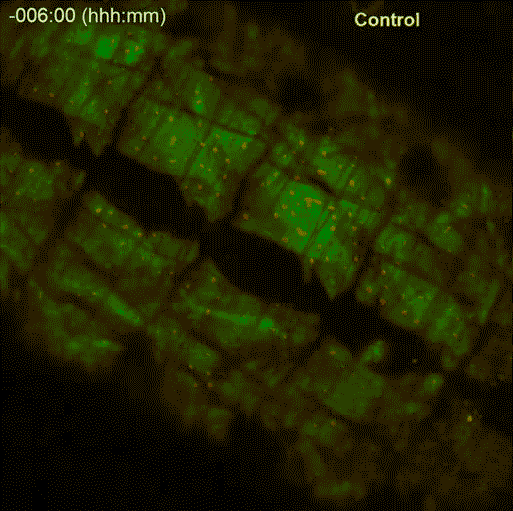
Illustrating the metamorphosis of muscles during the pupal stage of Drosophila to pupils. Source: movie taken and modified from Wikimedia (4).
For primary schools, the national school curriculum in England lists three relevant topics: inheritance, life cycle, and evolution (7), of which we chose the latter two. For both topics, Drosophila offers fantastic conceptual and experimental opportunities, as is detailed in our recent blog post (35). For example, pupils can observe and protocol the life cycle of flies in only two weeks and there is unique understanding of the metamorphosis that transforms Drosophila maggots into flies. The surprising fact that concepts of human biology can be discovered through work in flies is an example par excellence for concepts of deep homology, evolutionary trees, and the idea of common ancestors (11; this can be further enriched in secondary schools by uniquely enlightening fly examples of population genetics or speciation; 9; 3; 24). To actively engage the kids with evolution, they use microscopes to look at flies carrying marker mutations, and then use this experience to jointly invent an evolutionary tree.
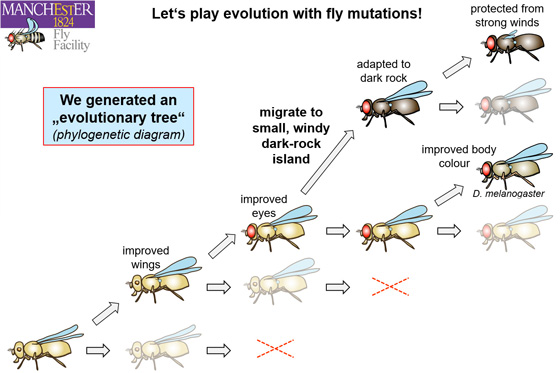
Screenshot from the evolution lesson. Fly images were generated using the free “Genotype Builder” (29; 41).
The key challenges: evaluating and marketing our resources
Developing our lesson pool was a lengthy and laborious process, yet it was only the first step; since then, we have been faced with the far greater challenge of (a) evaluating the lessons and (b) encouraging others to use them.
Carrying out evaluations is a science of its own and requires strategy, time, and human resources to degrees that must be carefully considered from the start (43). So far, we have used simple surveys. In these surveys, pupils usually expressed positive views about enjoyment of the event, seem to have gained new understanding of biology topics (details in 34and 35), and the data suggest that we are able to ignite an interest in Drosophila: thus, before our school visits, awareness of fruit fly research was low, whereas afterwards there was strong support for introducing Drosophila in classrooms and even the use of fruit flies in research. These results look very promising but will have to be properly validated, for example by using pre- versus post-event surveys to assess knowledge gain, long-term surveys to test knowledge retention, or homework tasks to appraise depth of understanding and of subject engagement.
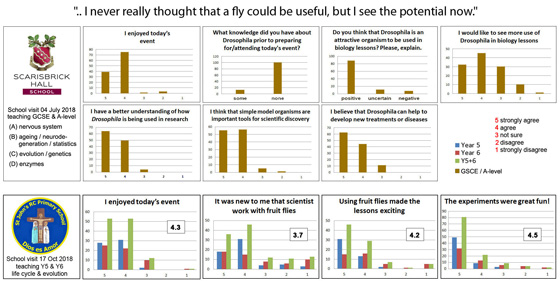
Evaluation results from a primary and a secondary school visit (details in 34; 35) demonstrating how lack of knowledge about Drosophila research can be turned into strong support. Click image to see a larger version.
To have maximum impact, we aim to encourage the use of our resources and ideas within the communities of teachers and drosophilists. This requires spreading awareness of the resources and facilitating their use. As an essential step to this end, we freely share our resources, for which we launched two dedicated figshare.com repository sites: the first one is primarily for teachers and hosts the six completed lessons (37); the second site is for drosophilists and provides access to extracurricular lessons and science fair materials (39).
As a further measure, we launched the droso4schools support website (20). This website introduces and links to our resources, provides lesson-specific pages with details about the content, and additional information about Drosophila (“Why fly?” and “Organs“).
These online resources provide proof-of-principle for our strategy and can now develop their own momentum, either by being actively used or serving as a template for resource development. With this in mind, we are promoting them through blog posts (30; 34; 35), talks and workshops at international conferences (31; 32; 40), journal articles for teachers (10) or drosophilists (26a), and finding allies who can help to drive the agenda politically or institutionally (see last section).
An appeal to scientists to join the school endeavor
What has been achieved so far with our school work is promising, as illustrated not only by the evaluations, but also by teacher and researcher comments from across the globe, as evidenced in our impact document (21). However, we hope that more teachers and drosophilists will be inspired to capitalize on our resources — be it using them as they are, adapting them for modified classes, or taking them as examples for designing lessons on new topics! If the principal strategy gains sufficient momentum and more of us adopt the necessary collaborative spirit across disciplines, communities and countries, and the relevant learned societies and science organizations drive the science education agenda politically (33), there is a realistic chance that flies can become established as routinely used teaching tools in schools — to the benefit of teachers, pupils, and researchers alike.
About the authors:
Both authors work at the Faculty of Biology, Medicine and Healthof The University of Manchester. Sanjai Patelis the manager of the Manchester Fly Facility, Andreas Prokopis professor of neurobiology and academic head of the facility, and together theydrive the “Manchester Fly Facility” initiative and the ‘droso4schools‘ project mentioned in this blog post.
References
(1) Archer, L., DeWitt, J., Osborne, J., Dillon, J., Willis, B., Wong, B. (2012). Science Aspirations, Capital, and Family Habitus:How Families Shape Children’s Engagement and Identification With Science. American Educational Research Journal 49,881-908 — (LINK)
(2) Blackburn, C. (2018). A droso4school CPD event for teachers. Blog post in“The Node” — (LINK)
(3) Brookes, M. (2001/2002). “Fly: The Unsung Hero of Twentieth-Century Science.” Ecco/Phoenix — (LINK)
(4) Chinta, R., Tan, J. H., Wasser, M. (2012). The study of muscle remodeling in Drosophila metamorphosis using in vivo microscopy and bioimage informatics. BMC Bioinformatics 13,S14-S14 — (LINK)
(5) Cohen, B. A. (2017). How should novelty be valued in science? Elife6,e28699 — (LINK)
(6) Croll, P. (2008). Occupational choice, socio-economic status and educational attainment: a study of the occupational choices and destinations of young people in the British Household Panel Survey. Research Papers in Education 23,243-268 — (LINK)
(7) Department for Education (2015). Statutory guidance – National curriculum in England: science programmes of study — (LINK)
(8) Fostier, M., Patel, S., Clarke, S., Prokop, A. (2015). A novel electronic assessment strategy to support applied Drosophila genetics training on university courses. G3 (Bethesda) 5,689-98 — (LINK)
(9) Green, J. E., Cavey, M., Caturegli, E., Gompel, N., Prud’homme, B. (2018). Evolution of ovipositor length in Drosophila suzukii is driven by enhanced cell size expansion and anisotropic tissue reorganization. bioRxiv — (LINK)
(10) Harbottle, J., Strangward, P., Alnuamaani, C., Lawes, S., Patel, S., Prokop, A. (2016). Making research fly in schools: Drosophila as a powerful modern tool for teaching Biology. School Science Review 97,19-23 — (LINK)
(11) Held Jr., L. I. H. (2017). “Deep homology? Uncanny similarities of humans and flies uncovered by evo-devo.” Cambridge University Press, Cambridge — (LINK)
(12) Jones, R., Wilsdon, J. (2018). It’s time to burst the biomedical bubble in UK research — (LINK)
(13) Kover, P., Hogge, E. (2016). Teaching Evolution for Primary Children (website) — (LINK)
(14) Kover, P., Hogge, E. (2017). Engaging with primary schools: supporting the delivery of the new curriculum in evolution and inheritance. Sem Cell Dev Biol — (LINK)
(15) Lawrence, P. (2016). The last 50 years: mismeasurement and mismanagement are impeding scientific research. Current Topics in Developmental Biology — (LINK)
(16) Maartens, A., Prokop, A., Brown, K., Pourquié, O. (2018). Advocating developmental biology. Development 145,dev167932 — (LINK)
(17) Maltese, A. V., Tai, R. H. (2011). Pipeline persistence: Examining the association of educational experiences with earned degrees in STEM among U.S. students. Science Education 95,877-907 — (LINK)
(18) Manchester Fly Facility. For the public (website) — (LINK)
(19) Manchester Fly Facility (2014). YouTube channel — (LINK)
(20) Manchester Fly Facility (2015a). droso4schools: Online resources for school lessons using the fuit fly Drosophila(website) — (LINK)
(21) Manchester Fly Facility (2015b). Manchester Fly Facility Resources. figshare,10.6084/m9.figshare.1328031 — (LINK)
(22) Martín-Bermudo, M. D., Gebel, L., Palacios, I. M. (2017). DrosAfrica: Establishing a Drosophila community in Africa. Sem Cell Dev Biol 70,58-64 — (LINK)
(23) Martínez-Arias, A. (2015). The case of the Irish Elk, a parable for the weight of the glamour journals. Blog post in “Martinez-Arias Lab Blog” — (LINK)
(24) Moreno, E. (2012). Design and construction of “synthetic species”. PLoS One7,e39054 — (LINK)
(25) Nerlich, B. (2017). Making science public: Taking stock. Blog post in “University of Nottigham Blog” — (LINK)
(26a) Patel, S., DeMaine, S., Heafield, J., Bianchi, L., Prokop, A. (2017). The droso4schools project: long-term scientist-teacher collaborations to promote science communication and education in schools. Semin Cell Dev Biol 70,73-84 — (LINK)
(26b) Patel, S., Prokop, A. (2017). The Manchester Fly Facility: Implementing an objective-driven long-term science communication initiative. Semin Cell Dev Biol 70,38-48 — (LINK)
(27) Patel, S., Prokop, A. (2018). An objective-driven long-term initiative to communicate fundamental science to various target audiences – a Drosophila case study. Blog post in“PLOS | BLOGS” — (LINK)
(28) Prokop, A. (2013a). 2ndyear Drosophila developmental genetics practical. figshare,m9.figshare.156395 — (LINK)
(29) Prokop, A. (2013b). A rough guide to Drosophila mating schemes. figshare,dx.doi.org/10.6084/m9.figshare.106631 — (LINK) http://dx.doi.org/10.6084/m9.figshare.106631
(30) Prokop, A. (2015a). Bringing life into biology lessons: using the fruit fly Drosophila as a powerful modern teaching tool. Blog post in “Gedankenexperimente” — (LINK)
(31) Prokop, A. (2015b) A comprehensive strategy to communicate Drosophila research to the public. F1000Research 4, 820 (slides). 24th Europ DrosophilaRes Conference (Org.: B. Edgar, I. Lohmann, A. Teleman, A. Ephrussi, E. Furlong, M. Leptin, M. Boutros), Heidelberg (09-12 Sept) — (LINK)
(32) Prokop, A. (2015c) Developing an objective-driven multifaceted strategy for Drosophila outreach and science communication. 56th Annual Drosophila Research Conference (Org.: G. Beitel, M. Eisen, M. Freeman, I. Rebay), Chicago, US (March 4-8) — (LINK)
(33) Prokop, A. (2017). Communicating basic science: what goes wrong, why we must do it, and how we can do it better. Blog post in “PLOS | BLOGS” — (LINK)
(34) Prokop, A. (2018a). How to communicate basic research in schools – a case study using Drosophila. Blog post in “PLOS | BLOGS” — (LINK)
(35) Prokop, A. (2018b). A novel and engaging approach to teaching life cycle and evolution in KS2 classrooms (primary schools). Blog post in “Gedankenexperimente” –(LINK)
(36) Prokop, A. (2018c). Why funding fruit fly research is important for the biomedical sciences. Open Access Govern 20,198-201 — (LINK)
(37) Prokop, A., Allan, S. (2016). The Brain Box — (LINK)
(38) Prokop, A., Patel, S. (2015). Biology lessons for schools using the fruit fly Drosophila. figshare, dx.doi.org/10.6084/m9.figshare.1352064 — (LINK)
(39) Prokop, A., Patel, S. (2016). Resources for communicating Drosophila research in schools and on science fairs. figshare,10.6084/m9.figshare.4262921 — (LINK)
(40) Prokop, A., Pulver, S., Steiger, R. (2018). Advocating Drosophila through using it as an efficient teaching tool (version 1; not peer reviewed – slides of an ADRC 2018 workshop organised by A. Prokop).F1000Research 7,465 (slides) — (LINK)
(41) Roote, J., Prokop, A. (2013). How to design a genetic mating scheme: a basic training package for Drosophila genetics. G3 (Bethesda) 3,353-8 — (LINK)
(42) Smaldino, P. E., McElreath, R. (2016). The natural selection of bad science. Royal Society Open Science 3— (LINK)
(43) Spicer, S. (2017). The nuts and bolts of evaluating science outreach. Sem Cell Dev Biol 70,17-25 — (LINK)
(44) Vicente-Crespo, M. (2015). Can the humble fruit fly help create a flourishing African scientific community? In “The Guardian”, pp. online — (LINK)
(45) Wellcome Trust (2014). Primary science: is it missing out? (report) — (LINK)
(46) Young, N. S., Ioannidis, J. P. A., Al-Ubaydli, O. (2008). Why Current Publication Practices May Distort Science. PLOS Medicine 5, e201 — (LINK)

